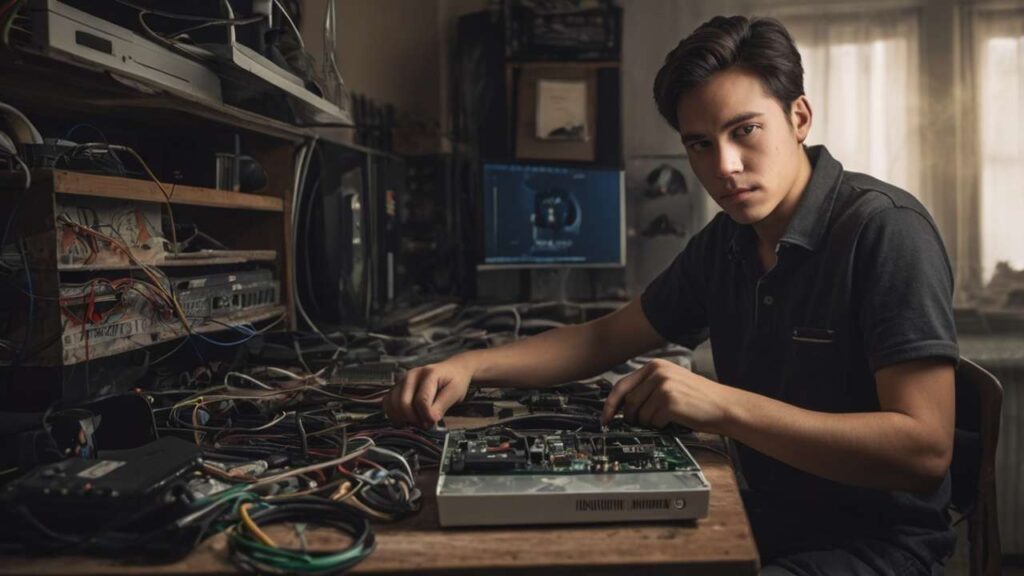Gamers know the sound. You boot up your PS4, Xbox, or Switch, and instead of quiet immersion you hear the roar of a jet engine. That screaming fan noise is not just annoying—it’s a warning. The console is struggling, often because thermal paste has dried out or dust is choking the fans. Ignoring it can kill your hardware long before its time, which is why understanding The Jet Engine Console: Signs You Need PS4/Xbox/Switch Thermal Paste and Fan Cleaning is crucial if you want to keep gaming without breakdowns.
I’ve been guilty of brushing it off before. “Ah, it’s just loud,” I thought, until my PS4 shut down mid-match. Turns out, the old thermal paste had turned into chalk and the fan blades were wearing a layer of dust thick enough to knit a sweater. A trusted repair shop fixed it, but the bill was a sharp reminder that preventative maintenance is always cheaper than repairs.
- Why Consoles Overheat in the First Place
- Signs You Need Fan Cleaning and Thermal Paste Replacement
- Inside the Professional Repair Process
- The Cost of Preventative Maintenance vs. Repair
- Preventative Maintenance Tips for Gamers
- Case Study: The PS4 Jet Engine
- Expanding the Conversation: Related Console Problems
- FAQs
Why Consoles Overheat in the First Place
Overheating isn’t magic—it’s mechanics. A console works by moving heat away from the CPU and GPU using thermal paste and a cooling fan. As thermal paste ages, it dries and loses conductivity, meaning heat no longer transfers efficiently. Add in layers of dust clogging the vents, and suddenly your console is gasping for air.
Professional repair experts explain it like this: “Imagine running a marathon with a winter coat on.” That’s your console every time dust and dried paste trap heat. Over time, constant overheating doesn’t just slow the system, it permanently damages chips, leading to total failure.
That’s why gaming console cleaning service is considered essential preventative maintenance. It’s not cosmetic; it’s survival.
Signs You Need Fan Cleaning and Thermal Paste Replacement
Loud fans are the obvious clue, but they’re not the only sign. Here’s what gamers often notice right before a breakdown:
- Console shutting down randomly in the middle of gameplay.
- Extreme fan noise even during menu screens.
- Games freezing or lagging due to throttled performance.
- The outer shell of the console feeling dangerously hot to touch.
- Persistent error messages linked to overheating.
Once you hit these symptoms, you’re already on borrowed time. A console overheating fix usually starts with fan cleaning and replacing the thermal paste, which breathes new life into the system.
Inside the Professional Repair Process
A proper cleaning and paste replacement is more detailed than people think. Reliable shops don’t just open the console and dust it with a can of air. They carefully disassemble the console, separate the heatsink from the processor, and remove the old paste with isopropyl alcohol.
Then comes the crucial part: applying a high-quality thermal paste evenly. Too much paste insulates, too little fails to transfer heat. Professional technicians use trusted brands like Arctic MX-4 or Noctua NT-H1, because cheap paste breaks down quickly.
The fan itself is cleaned with precision tools, sometimes even lubricated if bearings are dry. Dust removal often involves brushes and ESD-safe vacuums to ensure no particles linger. Only after all this is the system reassembled and tested under load to verify cooling performance.
Honestly, watching a skilled repair tech handle the process is like watching surgery. That’s the level of care your console deserves.
The Cost of Preventative Maintenance vs. Repair
Let’s talk numbers, because this is where many gamers hesitate. A PS4 loud fan repair or thermal paste replacement cost usually falls between $50 and $100 at a trusted shop. Compare that to replacing a fried motherboard or GPU, which can easily exceed $200—or worse, force you to buy a new console entirely.
It’s the same principle as car maintenance: skip the oil changes, pay for an engine rebuild later. Console care is cheaper, easier, and smarter. As one professional repair specialist said, “Dust kills more consoles than wear and tear ever will.”
If you’re in North Carolina and need reliable help, check out these best gaming console repair recommendations. A trusted shop doesn’t just fix the problem, they prevent future disasters.
Preventative Maintenance Tips for Gamers
Not every solution requires a screwdriver. There are habits every gamer can adopt to keep consoles cooler for longer:
- Keep the console in a well-ventilated area, never stuffed in a cabinet.
- Clean the exterior vents with compressed air monthly.
- Avoid using the console on carpets or beds where dust gets sucked in.
- Power down fully once in a while to let components cool.
- Schedule professional cleaning every 1–2 years, depending on usage.
Following these simple steps can double your console’s lifespan, which ties directly into another interesting discussion—how small daily habits, like the ones covered in 5 Simple Habits to Double Your Console’s Lifespan, can save gamers hundreds of dollars over time.
Case Study: The PS4 Jet Engine
A gamer I know had a PS4 that sounded like a hairdryer on steroids. He ignored it for months, assuming the noise was “normal.” Eventually, it overheated during a boss fight, shutting down permanently. The repair shop diagnosed old thermal paste and fans clogged with pet hair.
After a professional cleaning and new paste, the PS4 ran whisper-quiet, almost like brand new. The cost? $80. The lesson? That small investment avoided replacing the entire console for $400+. This real-world example shows the exact financial case for consistent preventative maintenance.
Expanding the Conversation: Related Console Problems
Thermal paste and fan cleaning aren’t the only pain points console owners face. HDMI port damage, for example, can look like a dead console when in reality it just needs professional micro-soldering. Nintendo Switch users also struggle with charging failures tied to the M92 chip and USB-C port, a deep dive repair that’s become increasingly common.
Gamers often debate whether to repair or replace consoles after major issues, a decision that requires a clear cost-benefit analysis. And of course, beyond repairs, prevention is always the best weapon—small habits keep systems healthier.
Looking forward, conversations are expanding into even bigger territory: sustainability in console repair, eco-friendly recycling of parts, and even the role of AI in predictive diagnostics. These aren’t just “future content ideas”—they’re natural next steps in the repair community that gamers will benefit from understanding.
For consistent updates and professional advice, the Gaming Console Repair category on Pro Service Tips is a reliable place to stay informed.
FAQs
1. How often should I replace thermal paste on my console?
Most professionals recommend every 2–3 years, depending on how heavily the console is used and the environment it operates in.
2. Can I clean my console fans myself?
Surface dusting is fine, but deep fan cleaning requires disassembly. Doing it wrong can damage components, so professional service is safer.
3. Why does my console sound like a jet engine even after cleaning the outside?
It usually means the issue is internal—either old thermal paste, blocked heatsinks, or fans that need proper servicing.
The phrase The Jet Engine Console: Signs You Need PS4/Xbox/Switch Thermal Paste and Fan Cleaning isn’t just a catchy headline—it’s a reality check. A loud, hot console is not normal. It’s a cry for help.
By investing in preventative maintenance, gamers avoid expensive breakdowns, extend the lifespan of their consoles, and enjoy quieter, smoother gameplay. Whether it’s a fan clogged with dust or thermal paste that’s turned to powder, the fix is available, affordable, and worth it.
Don’t wait for the shutdown screen to teach you the hard way. Book a cleaning, replace that paste, and breathe easy knowing your console won’t take off like a jet mid-game.
If this article helped, tap the share buttons below and spread the word to fellow gamers—it might just save someone else’s console from an early grave.
For more insights, tips, and expert advice, explore Pro Service Tips.


